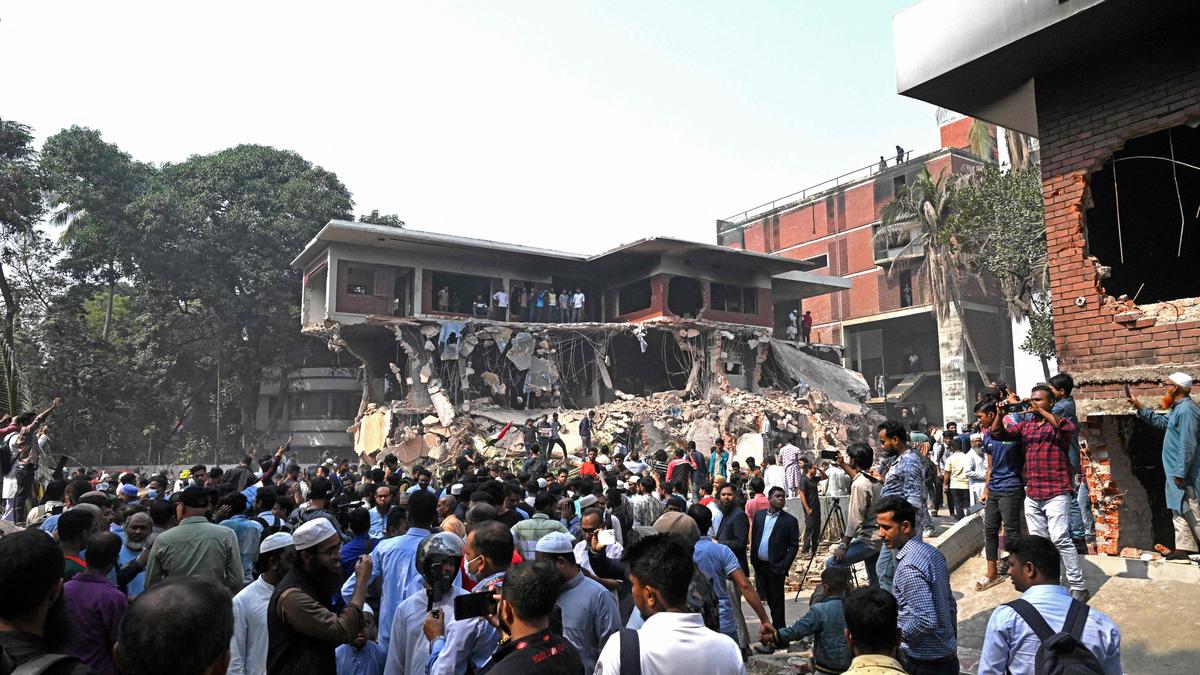
How a Dhaka mob brought down the residence of Sheikh Mujibur Rahman Premium
The Hindu
Witnesses recall the demolition of Bangabandhu Sheikh Mujibur Rahman's residence, sparking historic protests and political turmoil in Bangladesh.
Fazlul Haque, a 63-year-old businessman from Narayanganj, travelled to Bangladesh’s capital Dhaka on the morning of February 6 to witness the demolition of Bangabandhu Sheikh Mujibur Rahman’s residence at Dhanmondhi-32, which began the previous night.
Recalling the moment he heard the news, he said, “When I saw the demolition of Dhanmondi-32 on Facebook on Wednesday (February 5) , I couldn’t stay back. I immediately decided to come to Dhaka. I have seen the wrongdoings of the Awami League for years, and I wanted to witness their downfall with the demolition of this house.”
Not only Mr. Haque, but thousands of people gathered at Dhanmondi-32 — the iconic residence where the father of ousted Bangladeshi Prime Minister Sheikh Hasina and the leader of Bangladesh’s liberation war lived and was assassinated. The building, which also housed the Bangabandhu Memorial Museum, became the focal point of a historic moment as crowds gathered to witness its demolition. Many came simply to watch, while others arrived with the intent of taking part in the vandalisation.
Abrar Hamim, a student activist, said: “Shortly after I saw a Facebook post calling for the demolition of Dhanmondi-32 residence, I left my house for Shahbagh and joined the student march. We walked nearly four kilometres in protest, but by the time we arrived, people had already begun vandalising the house in anger. I returned home at dawn when a significant section of the building had already been destroyed. Everyone, including the protesting students of the July uprising, agreed to demolish it — because, to us, it is the pilgrimage site of fascism.”
February 5 marked six months since the mass uprising that toppled the 16-year regime of Ms. Hasina in Bangladesh. The ousted leader had announced a speech to be broadcast on the Facebook page of banned student outfit Bangladesh Chhatra League that night. In response, protesters, including students from the Anti-Discrimination Student Movement and online activists, announced an event titled “Bulldozer March”, scheduled to coincide with the online programme of Ms. Hasina, calling for a demonstration against the speech broadcast.
They planned to gather at Shahbagh before marching to Dhanmondi-32. However, by 8:00 p.m., enraged students and people from different walks of live had already started assembling at the site, chanting slogans. At one point, protesters forcefully broke the gates of Sheikh Mujibur’s residence and stormed inside, vandalising the property. Demonstrators began tearing down the boundary walls of the residence using sticks and crowbars when a military team arrived at the residence but withdrew after a brief presence. By 10:30 p.m., the protest escalated further as Ms. Hasina’s residence, Sudha Sadan, was set on fire. The Fire Service was informed of the fire at Sudha Sadan but did not intervene, citing security concerns. Meanwhile, by 11:00 p.m., protesters brought a crane to Dhanmondi-32, soon followed by an excavator. Around midnight, the protesters began to use heavy machinery to demolish large sections of the building, with the destruction continuing until around 2:00 in the morning. Protesters remained on-site throughout the night. Law enforcers were also seen nearby since the beginning.
More people began to gather at Dhanmondi-32 in the morning of February 6, cheering as they saw most of the building reduced to rubble. The excavators left the scene by 10:30 a.m., leaving the house of Sheikh Mujibur Rahman to be torn apart by hands. A large crowd remained in front of the site, while some individuals entered the building to take books, steel, iron, tin, and wood.













